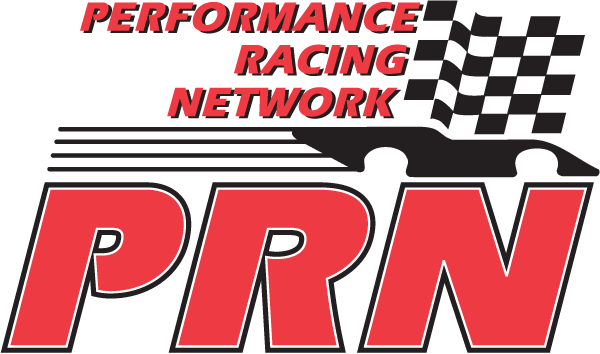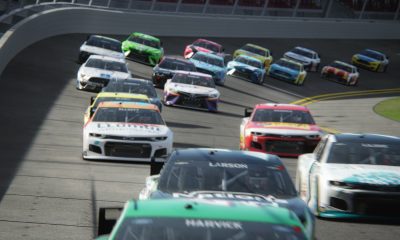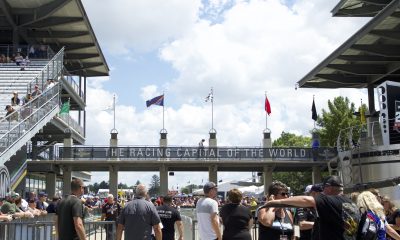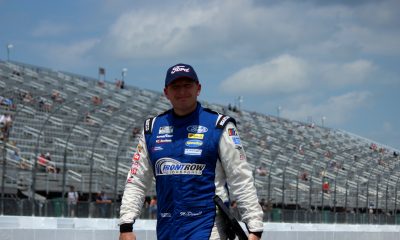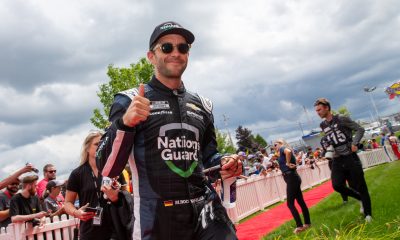For 38 weekends every year the traveling circus we like to call NASCAR will hit the road and for half of those broadcasts, the crew for PRN — The Performance Racing Network will have the call of the Xfinity Series and Monster Energy NASCAR Cup Series events.
Tuning in to a race on radio was once the only way you could get a NASCAR broadcast, that’s not the case today with TV, social media, streaming services and other outlets. But, for many NASCAR fans, the race on radio is true “artistry in motion”.
This past weekend at Kentucky I was able to take in, not only the sights and sounds of the race itself, but the broadcast with the crew of the Performance Racing Network, which is headed by president and anchor Doug Rice.
You as a fan tune at a certain time to hear the broadcast, but the work to make that happen, begins well in to the early hours of a race day.
For many of these race weekends it consists of not just one race, but typically two as was the case at Kentucky. The PRN crew geared up for the Xfinity race on Friday, and the MENCS race on Saturday, but Mother nature intervened and turned a long weekend in to a long broadcast day on Saturday.
Before the crews for PRN even show up, the mobile command center, the big tractor trailer shows up early in the week to get everything wired up and in place for the announcers.
The majority of the talent shows up early Friday to begin their broadcast prep which consists of meetings with NASCAR, pulling practice and stat sheets, getting audio from press conferences, driver interviews and sponsor commitments.
Now, sometimes that goes easy, or mother nature jumps in, as she did on Friday and washes everything out.
Doug Rice and Mark Garrow were in the booth for Qualifying and what was supposed to be the Xfinity race Friday night, but rain moved in and forced them out of the booth and fans from the grandstands as Qualifying was called early and the Xfinity race cancelled due to safety concerns for the fans.
These delays are just another part of the game and the PRN crew was prepared perfectly to run a double header on Saturday, it just meant an even earlier arrival for everyone from Alexis Perkins who handles all of the PR and communication for Doug and the rest of the PRN staff, to Herrill Hamrick the lead engineer who now goes in to flood duty mood to make sure all of the electronics needed for the broadcast aren’t waterlogged. They all begin to trickle in to the media center early Saturday morning and finalize all of the plans for the running of both races.
Doug would take the first race off and delegate duties, allowing Mark Garrow and Brad Gillie to hold down the broadcast booth while a long day in the sun for veteran turn announcers Rob Albright and Pat Patterson were about to commence.
One thing fans might notice on an Xfinity Broadcast compared to a Cup series broadcast are sometimes two fewer pit reporters. Due to the number of top running cars on an Xfinity broadcast allow for just two reporters on pit road, which on Saturday went to Wendy Venturini and Brett McMillian.
Following a smooth broadcast of the Xfinity race, The PRN crew will gather in the media center or the mobile command center to debrief and in this instance, relax for a few minutes, then begin to reset for race number two that evening. But, it’s not cold drinks and couches, there is still work to be done.
It’s time for a quick lunch then the production meeting to get everyone in line for special information from NASCAR, sponsors but track related and broadcast related. The crew will go over specific timing for things such as infield care center reports. Why don’t you get those sometimes? That answer was simple as it came from Rice, “We can’t miss restarts”. He said it never fails, the pace car is on the backstretch and someone keys up from the care center saying we’ve got this driver. But, it would run in to a restart. This meeting is where all of the announcers, producers and engineers get on the same page, so you have a smooth broadcast in your ear. Once it’s finished more prep work.
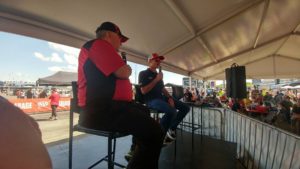 Doug Rice is always on the go, following up with drivers, crew chiefs, NASCAR, and doing special events, which was the case on Saturday. Fan Q&A set up in a tent just outside of Victory Lane, Doug, Alexis Perkins and myself would make our way to spend some time with Kyle Larson, Jamie McMurray, Matt DiBenedetto, Jeffery Earnhardt and Ben Rhodes and hundreds of NASCAR fans. It’s a time consuming proposition, but one that is not only vital to the track, but the drivers as well. It’s informative, but mainly it’s a about having some fun with the personalities of the sport. Drivers and announcers alike.
Doug Rice is always on the go, following up with drivers, crew chiefs, NASCAR, and doing special events, which was the case on Saturday. Fan Q&A set up in a tent just outside of Victory Lane, Doug, Alexis Perkins and myself would make our way to spend some time with Kyle Larson, Jamie McMurray, Matt DiBenedetto, Jeffery Earnhardt and Ben Rhodes and hundreds of NASCAR fans. It’s a time consuming proposition, but one that is not only vital to the track, but the drivers as well. It’s informative, but mainly it’s a about having some fun with the personalities of the sport. Drivers and announcers alike.
After all of the sponsor commitments, track activities, interviews that needed to be recorded and stat work is done, then real work begins. It’s time for Doug, Mark Wendy and producer Laura Beth to head to the booth. Then turn announcers Rob Albright and Pat Patterson will head in to the truck along with pit reporters, Jim Noble, Brad Gillie, Steve Richards and Brett McMillan as they get all wired up for preprace.
As you listen on your radio, it’s sounds seamless, and the transitions are as smooth as glass, but in the ear of everyone connected to the big sound board in the PRN truck that sits just behind victory lane, it’s organized chaos. Laura Beth has her programming schedule synced up with the truck, she makes the calls, 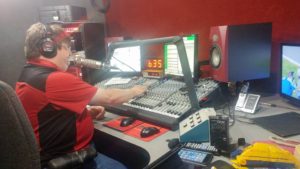 Harrill pushes the buttons, and even with the best in the business, sometimes you’ll hear “Oh no, wait!” and Doug Rice does his best fill.
Harrill pushes the buttons, and even with the best in the business, sometimes you’ll hear “Oh no, wait!” and Doug Rice does his best fill.
NASCAR radio broadcasts have long been thought by fans that they show up, and describe the action. To say that is putting it in the simplest terms would be an understatement.
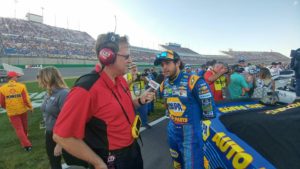 As Jim Noble explained after interviewing Chase Elliott for the specialized NAPA segment, things are put in specific places based on what sponsors and advertisers request. “It’s not like TV where you are expected to have someone at a specific time”, but grab and go and get as many as you can.
As Jim Noble explained after interviewing Chase Elliott for the specialized NAPA segment, things are put in specific places based on what sponsors and advertisers request. “It’s not like TV where you are expected to have someone at a specific time”, but grab and go and get as many as you can.
Once the green flag waves and the play by play is going, the commentary is flowing, that’s the fun and almost the easy part. Even for the guys on pit road. Four reporters for 40 race cars.
As I shadowed Jim Noble from preprace, to postrace. I found out that it’s not just about watching cars in the pitbox for twelve seconds. You are on top of everything from start to finish. Noble had the broadcast in one ear and the cars that he was covering on a scanner in the other. He said he use to have NASCAR on the scanner as well, but that was just to much.
As a pit reporter you have to be able to recognize a crew chief, driver and spotters voice immediately. That’s really where you are getting your information.
It’s not as much about climbing up on that pit box and talking to the team as it is listening and taking in details.
During the broadcast, you’ll hear Doug Rice say lets take a sweep down pit road. Jim, Brett, Brad and Steve all have to be ready with quick descriptions of cars in their segments. The main focus has to be who is running up front.
When it comes to pit stops, it’s about getting the information in and out quickly. Lingering on an issue with a car delays a hand off to the next reporter. Noble adds that their cars could be done and gone by the time you get to them.
The term “less is more” really comes in to play on pit road. Get the quick details and send it on down the line.
Once a pit stop sequence is over, then the running comes in to play. For Noble, his top cars were Jamie McMurray and Kurt Busch. McMurray was in the first pit stall of his segment, Busch was in the last.
So what goes on during that run? Stops at each of your pit boxes to get an update on the cars handling. This in recent years has gotten easier as PR reps will make notes of the changes done on a pit stop. They will then hand them off to the pit reporter which allows them to have a detailed report when it’s time for the pit sweep.
Get your running shoes on if you want to work on pit road.
For Jim Noble it was a case of really have to run.
After a report on pit road of Jimmie Johnson’s accident, the car turned in to the garage. Now, with NASCAR’s new wrecked car policy which forces a driver to the care center, even if they drove to the garage, it becomes decision time.
It’s a lot of “troubleshooting” once you make that run to the garage. Is the car being worked on, is it done for the night, is the driver on the way to the care center? Will time allow for a report? A lot of questions, not a lot of time.
You have to be paying attention at all times and ready to run even quicker.
So what happens if all of the cars in a pit reporters segment are out of contention? A nap was the quick answer. Noble quickly rescinded that answer and said that he would help out another reporter. Plus there is always the garage and care center coverage.
It’s never over till the checkered flag, and even then, it’s post race on pit road. It’s quickly out to the car and a quick post race interview. Or in some cases, finding out why a driver disappeared so quickly, as was the case with Kyle Busch.
It was a long day, and for most, it’s a late flight back to Charlotte. The crew will get a little rest, then begin preparation for the following week. This week PRN is back at it in New Hampshire.
For Doug Rice, meetings, debriefs, follow ups and hosting Fast Talk on Monday night to break it all down.
For Pat Patterson, a quite morning in an empty track for his show on SiriusXM NASCAR Radio Sunday morning. Brad Gillie is on the air immediately with the SiriusXM NASCAR radio post race show. Jim Noble hosts Tradin’ Paint Monday through Friday. Other members of the PRN crew have weekly duties including stories for the website plus interviews for other PRN shows.
It’s a never ending cycle for the members of the Performance Racing Network. A cycle, and life none of them would ever change.
And just ask Jim Noble. These guys don’t “drop the mic”
A radio broadcast is never simple–From Doug Rice down, his crew just makes it sound like it is.
If it races, I'll write about it, talk about it or shoot it with a camera. I began pursuing a career in motorsports journalism immediately after attending college at Kent State University. I have hosted multiple Motorsports talk shows, worked in Country Music radio, and now i spend every day on the air in the morning with 1300 and 100.9 WMVO and in the afternoons watching the roadways around Central Ohio for 93.7 WQIO. The excitement and the fans make everything I put out there worth while, it's been an exciting 15 years having covered everything from the Daytona 500 to the Rolex 24 and you can find me at pretty much any event run at Mid-Ohio Sports Car Course. What I like to bring is a look behind the scenes, a look at what and who makes the sport grow. From the guy that welds pieces back at the shop to the host in the tv booth. Everyone has a story and I like to tell it. My main focus here at TPF is looking at the men and women behind the microphone and cameras. My life long goal is to become a member of MRN or PRN Radio and bring the races to you. I hope that what I share now is enjoyable and gives you a unique look in to the world of motorsports. See you at a track soon

